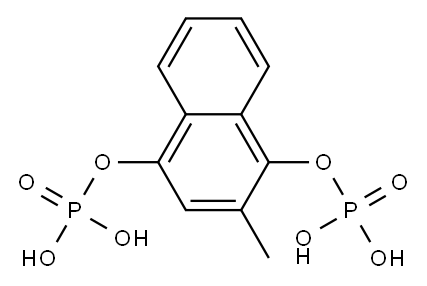2,000 g 2-methyl-1,4-naphthohydroquinone diphosphoryl chloride (from the quinone and POCl3) are dissolved in 2 liters ether and decomposed with 2 liters distilled water. The mixture is transferred to a separatory funnel and the aqueous layer separated from the ether layer, the latter being discarded. The aqueous layer is extracted with a further 2 liters of ether and again separated and discarded. The aqueous solution of the 2-methyl-1,4- naphthohydroquinone diphosphoric acid is extracted with successive portions of isobutyl carbinol in 500 cc quantities until the aqueous layer becomes almost colorless, after which this latter is discarded. The isobutyl carbinol solution is then concentrated to remove water and hydrochloric acid, and the crystalline residue neutralized with sodium hydroxide solution. The resulting solution of the sodium salt of 2-methyl-1,4-naphthohydroquinone diphosphoric ester is extracted with two successive portions of 1 liter acetone each and the
latter discarded. Methanol and acetone are then added, filtered, and the
product brought to crystallization by heating. Crystals of the sodium salt of 2-
methyl-1,4-naphthohydroquinone diphosphoric acid ester are sucked off. The
substance contains much moisture of crystallization and is dried in vacuum
until it contains 21-22% moisture of crystallization as determined by drying at
145°C at 2 mm vacuum.

